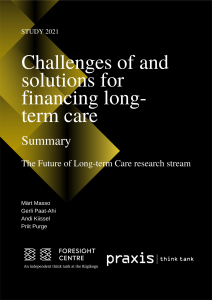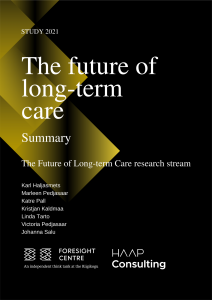The Future of Long-term Care

The project on the future of long-term care studies various possibilities in supporting the quality of life of people who need assistance over longer periods. The study maps the current state of the need for assistance, creates future scenarios of the need for assistance, analyses the options in the provision of care and discusses advantages and disadvantages of financing schemes that can cover the costs.
The number of people who need assistance and institutionalised assistance is increasing. The life expectancy in Estonia has increased noticeably in recent decades, but the years of healthy life have not grown equivalently. The continuing extension of life expectancy leads to an increase in the number of people who need help. The ratio between people who need assistance and people capable giving care is on a particularly sharp upward trend when considering the low birth rate. As a result of increased mobility, children no longer live close to their parents and against the backdrop of the low birth rate, many people do not have children who could provide assistance. Therefore, the institutionalised need for assistance is expected to increase significantly in the future.
In Estonia, the responsibility for long-term care is divided between the state, local governments and the close ones of the people who need assistance. Compared to other European Union countries, the share of the assistance funded from the public sector budget is small in Estonia. A significant part of the cost is borne by the person who needs assistance and his or her close ones.
Although the share of people who need some long-term care is large, it is not known whether and when the need for assistance emerges during a person’s lifespan. For many, the amounts spent on assistance in the final years of a person’s life are significant and exceed the income during this period of life. The pension system can help there, but it does not solve the problems related to long-term care. Moreover, younger people with disabilities need constant assistance throughout their life and they have no opportunity to raise the necessary means by themselves.
The study first maps the needs of people who need assistance now and makes scenarios about the future needs. These scenarios are taking into account relevant trends in the population, health and the social system in order to see what problems are likely to be faced in the future to understand what kind of assistance will be needed. The study documents the need for help from the perspective of the society and from the perspective of an individual. The two views help to understand the choices made by people within the policy framework. Prevention plays an important role avoiding costs and so the study looks at different ways to prevent the emergence of a care need, including promoting healthy ways of living and supporting individual subsistence.
Secondly the project studies the provision of care. There are many options possible for the future, such as formalised and institutionalised approaches as well as non-formal systems where close ones or volunteers provide assistance. What are the expectations and wishes for future care by different population groups? Moreover, technological developments offer new opportunities. Which of the currently existing technologies have the potential to affect our livelihood in the future and what the necessary conditions are for the technology to be adopted by many people?
As a third topic, the study proposes funding options and weighs their advantages and disadvantages as the provision of assistance requires resources. The options cover private and public insurance, various taxes, possibilities of the using the resources of the person in need or the close ones. What are the conditions under which certain options are more likely or preferred? When mapping potentially sustainable funding solutions, capitalised systems as well as pay-as-you-go solutions are discussed.
Reports linked to the research
News linked to the research
-
03.06 2021The financing needs of long-term care will multiply
At present, the public sector of Estonia spends more than 100 million euro per year on long-term care, but during the next 50 years, the annual need for providing long-term care services may increase to nearly 900 million euro (if expenses are calculated on the basis of today’s level of prices and wealth), the OECD predicts. Estonia’s possibilities were discussed at the Foresight Centre web seminar “Long-term care: where to find the money for it?”, held on 3 June.

 An independent think tank at the Riigikogu
An independent think tank at the Riigikogu 




